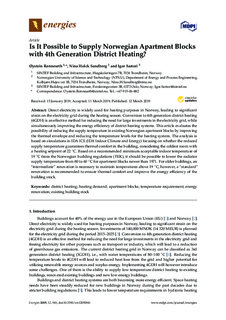| dc.contributor.author | Rønneseth, Øystein | |
| dc.contributor.author | Sartori, Igor | |
| dc.contributor.author | Sandberg, Nina Holck | |
| dc.date.accessioned | 2019-03-18T07:58:48Z | |
| dc.date.available | 2019-03-18T07:58:48Z | |
| dc.date.created | 2019-03-15T16:01:45Z | |
| dc.date.issued | 2019 | |
| dc.identifier.issn | 1996-1073 | |
| dc.identifier.uri | http://hdl.handle.net/11250/2590366 | |
| dc.description.abstract | Direct electricity is widely used for heating purposes in Norway, leading to significant strain on the electricity grid during the heating season. Conversion to 4th generation district heating (4GDH) is an effective method for reducing the need for large investments in the electricity grid, while simultaneously improving the energy efficiency of district heating systems. This article evaluates the possibility of reducing the supply temperature in existing Norwegian apartment blocks by improving the thermal envelope and reducing the temperature levels for the heating system. The analysis is based on simulations in IDA ICE (IDA Indoor Climate and Energy) focusing on whether the reduced supply temperature guarantees thermal comfort in the building, considering the coldest room with a heating setpoint of 22 °C. Based on a recommended minimum acceptable indoor temperature of 19 °C from the Norwegian building regulations (TEK), it should be possible to lower the radiator supply temperature from 80 to 60 °C for apartment blocks newer than 1971. For older buildings, an “intermediate” renovation is necessary to maintain temperatures above 19 °C, however, a “standard” renovation is recommended to ensure thermal comfort and improve the energy efficiency of the building stock. | nb_NO |
| dc.description.abstract | Is It Possible to Supply Norwegian Apartment Blocks with 4th Generation District Heating? | nb_NO |
| dc.language.iso | eng | nb_NO |
| dc.publisher | MDPI | nb_NO |
| dc.relation.uri | https://www.mdpi.com/1996-1073/12/5/941 | |
| dc.rights | Navngivelse 4.0 Internasjonal | * |
| dc.rights.uri | http://creativecommons.org/licenses/by/4.0/deed.no | * |
| dc.title | Is It Possible to Supply Norwegian Apartment Blocks with 4th Generation District Heating? | nb_NO |
| dc.type | Journal article | nb_NO |
| dc.type | Peer reviewed | nb_NO |
| dc.description.version | publishedVersion | nb_NO |
| dc.source.volume | 12 | nb_NO |
| dc.source.journal | Energies | nb_NO |
| dc.source.issue | 5 | nb_NO |
| dc.identifier.doi | https://doi.org/10.3390/en12050941 | |
| dc.identifier.cristin | 1685196 | |
| dc.relation.project | Norges forskningsråd: 257660 | nb_NO |
| dc.description.localcode | © 2019 by the authors. Licensee MDPI, Basel, Switzerland. This article is an open access article distributed under the terms and conditions of the Creative Commons Attribution (CC BY) license (http://creativecommons.org/licenses/by/4.0/). | nb_NO |
| cristin.unitcode | 194,64,25,0 | |
| cristin.unitname | Institutt for energi- og prosessteknikk | |
| cristin.ispublished | true | |
| cristin.fulltext | original | |
| cristin.qualitycode | 1 | |

